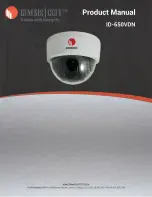
V1.02
Thom Hogan’s Complete Guide to the Nikon D300
Page 420
Shooting Controls
Many of the shooting controls of the D300 have already been
covered in earlier sections, but a few important ones remain
to be described.
Shutter Releases
The D300 sports the usual shutter release at the right-front top
of the camera. If you’re using an MB-D10 mounted to your
camera, there is a second release for when you hold the
camera for vertical shots. Both releases have Front and Rear
Command dials (unlike some previous Nikon bodies, where
no vertical release has had both). An
AF-ON
button also is
present near the vertical release on the MB-D10, but no
AE-
L/AF-L
button is present.
Note that the vertical release has a lock ring around it. When
the dot on the ring is aligned with the white line on the body,
the vertical release is active; otherwise it is inactive. Get used
to flipping that Vertical Release Lock switch; if left unlocked,
you’re pretty much guaranteed to get random pictures you
didn’t want as your hand and other things brush by the shutter
release on the MB-D10 grip.
Personally, I rarely use the MB-D10 vertical release. I, like
many professionals, use quick release mounts on my cameras
(most of the time the camera is used on a tripod). Thus, I have
an L-bracket mounted on my cameras most of the time. When
I grasp the camera to shoot vertically as Nikon intends me to,
my palm then rests uncomfortably on the bracket. It also
doesn’t help that it takes relatively large hands to feel
comfortable with the location of the Direction pad when
shooting verticals. Long ago I learned how to shoot vertical
with only the regular shutter release, so that’s all I tend to use.
Use the MB-D10 and its vertical release should you desire,
but don’t set the
AE-L/AF-L
button options if you do,
otherwise you’ll be frustrated by not being able to reach the
AE-L/AF-L
button (yes, you can transfer the function to the
AF-ON
button, but then you lose that button’s function).
















































